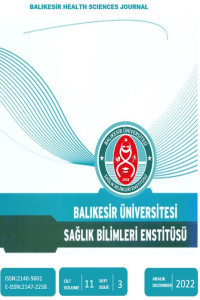PERİODONTAL HASTALIKTA YAŞLILIK İLE KEMİK MARKIRLARININ İLİŞKİSİ
yaşlılık, kemik yapım-yıkım markırı
RELATIONSHIP BETWEEN AGEING AND BONE TURNOVER MARKERS IN PERIODONTAL DISEASE
ageing, bone turnover markers,
___
- 1. Berg R, Morgenstern NE: Physiologic changes in the elderly. Dent Clin North Am 1994; 41(4):651-668.
- 2. Viidik A: The Biological Basis of Aging. Holm-Pedersen P-Löe H (Ed.): Geriatric Dentistry. A Textbook
- 3. Zach L: The Oral Cavity. Rossman I (Ed.): Clinical Geriatrics. J.B. LippincottCo. Pbiladeiphia. 1979, s 618-637.
- 4. Gershen JA. Geriatric Dentistry and prevention.Adv. Den. Res. 5:67-73 ,1991.
- 5. Petersen PE. The World Oral Health Report 2003: Continuous improvement of oral health in the 21st century - The approach of the WHO Global Oral Health Programme. Community Dent Oral Epidemiol 2003;31 (Suppl.1):3-24.
- 6. Hansen G; An epidemiologic investigation of The effect of biologic aging on the breakdown of periodontal tissue. J. Periodontol 1973; 44(5):269-277.
- 7. Hunt R, Levy S, Beck J: The prevalance of periodontal attachment loss in an Iowa population aged 70 and older. J Pub Health Dent 1990; 50(4):215-256.
- 8. Abdellatif HM, Burt BA: An. epidemiological investigation into the relative importance of age and oral hygiene status as determinants of pedodontitis. J Dent Res 1987; 66 (1);13-18.
- 9. Palmqvist S, Sjödin B: Alveoler bone levels in a geriatric Swedish population. J Clin Periodontol 1987; 14 (2): 100-104.
- 10. Betts NJ, Barber HD: The Pathophysiology of Aging, Fonseca RJ-Davis WH (Ed.): Reconstructive Preprosthetic Oral and Maxillofacial Surgery. W.B.Saunders Co, Philadelphia, 1995, s 10-13.
- 11. Massler M: Geriatric nutrition II: Dehydration in the elderly. J Prosthet Dent 1979; 42(5):489-491.
- 12. Meurman JH: Dental infections and general health. Quint Int 1997; 28(12)807-811.
- 13. Kutsal YG, Çakmakçı M, Ünal S: Geriatri Hakimler Yayın Birliği, Ankara, 1997, Cilt 1-2.
- 14. Shay K., Ship JA: The importance of oral health in the older patient. J Am Geriatr Soc 1995; 43(12):1414-1422.
- 15. Informational paper. Modulation of the host response in periodontal therapy J. Periodontol 2002;73: 460-470.
- 16. Özmeric N. Advences in periodontal disease markers. Clinica Chimica Acta 2004; 343: 1-16.
- 17. Delaney MF, LeBoff MS. Metabolic bone diseases. In: Ruddy S, Harris EDJr, Sledge CB editors. Kelley’s Texbook of Rheumatology, Philadelphia WB Saunders. 2001; 1635–52.
- 18. Carranza FA, Newman MG clinical periodontology 8 th. Eg. W.B. Saunders Co, 51-55 1996.
- 19. Özgürtaş T, Kutluay T: Yeni kemik markırları ve klinik kullanımları. Gata Biyokimya ve Klinik Biyokimya AD. T Klin. Tıb. Bilimileri 2001:523-527.
- 20. Pagani F, Francucci CM, Moro L. Markers of bone turnover: biochemical and clinical perspectives. J Endocrinol Invest. 2005; 28(10): 8–13.
- 21. Swaminathan R. Biochemical markers of bone turnover. Clin Chim Acta, 2001:313: 95-105.
- 22. Parfitt A.M., Simon I.S., Villanueva A.R. et al. Procollagen type I carboxy-terminal extension peptide in serum as a marker of collagen biosynthesis in bone: correlation with iliac bone formation rates and comparison with total alkaline phosphatase. J Bone Miner Res, 1987:2: 427–436.
- 23. Raisz L., Smith J. A., Trahiotis M. et al. Short-term risedronate treatment in postmenopausal women, effects on biochemical markers of bone turnover. Osteoporosis Int, 2000:11: 615-20.
- 24. Raisz LG, Wiita B, Artis A. And et al. Comrarison of effects of estrogen alone and estrogen plus androjen on biochemical merkers og bone formation and resoption in postmenopausal women.J Clin Endocrinol Metab 1996; 81: 37-43
- 25. Demers LM. Clinical usefulness of markers of bone degradation and formation. Scand J Clin Lab Invest 1997;57(Suppl 227):12-20.
- 26. Koide, M., Kinugawa, S., Takahashi, N. and et al. Osteoclastic bone resorption induced by innate immune responses. Periodontol 2000 2010:54, 235-246.
- 27. Matkovic V, Jelic T, Wardlaw GM and et al. Timing of peak bone mass in Caucasian females and its implication for the prevention of osteoporosis. Inference from a cross-sectional model. Journal of Clinical Investigation 1994: 93(2):799-808.
- 28. Ho AY, Kung AW 2005 Determinants of peak bone mineral density and bone area in young women. Journal of Bone and Mineral Metabolism 23(6):470-5.
- 29. Kanis JA, Adami S 1994 Bone loss in the elderly. Osteoporosis International 4 Suppl 1:59-65.
- 30. Ebeling PR, Atley LM, Guthrie JR, et al. Bone turnover markers and bone density across the menopausal transition. J Clin Endocrinol Metab 1996; 81:3366–3371.
- ISSN: 2146-9601
- Yayın Aralığı: Yılda 3 Sayı
- Başlangıç: 2012
- Yayıncı: Balıkesir Üniversitesi
ERKEĞİN KADINA YÖNELİK ŞİDDETE BAKIŞI VE TUTUMU
A Gökçe DEMİR, Gizem Deniz BULUCU, Ayşegül ÖZCAN
Ahmet Haktan SİVRİKAYA, Sibel Karaca SİVRİKAYA, Özlem Şahin ALTUN
HEMŞİRELİKTE ELEŞTİREL DÜŞÜNMENİN KLİNİK KARAR VERMEYE ETKİSİ
İNTRAPANKREATİK LİPOM: GÖRÜNTÜLEME BULGULARI
Erdoğan BÜLBÜL, Bahar YANIK KEYİK, Murat YILDAR, Gülen DEMİRPOLAT, Bahri KEYİK
HEMŞİRELERİN İŞ YAŞAMI KALİTELERİ İLE HASTA MEMNUNİYETİ ARASINDAKİ İLİŞKİNİN İNCELENMESİ
Ruşen ÖZTÜRK, Duygu GÜLEÇ, Sezer ER GÜNERİ, Ümran SEVİL, Nalan GÜRMEN
PERİODONTAL HASTALIKTA YAŞLILIK İLE KEMİK MARKIRLARININ İLİŞKİSİ
Sabri Fatih KURŞUNLU, Veli Özgen ÖZTÜRK
Semra KARACA, Ünsal BARLAS, Nevin ONAN, Yüksel Can ÖZ
HİPERTANSİYONLU BİREYLERDE TAMAMLAYICI VE ALTERNATİF TEDAVİ KULLANMA DURUMU
Şefika Dilek GÜVEN, Gamze MUZ, Nuriye Efe ERTÜRK, Ayşegül ÖZCAN
SAĞLIK ÇALIŞANLARININ SAĞLIĞI VE GÜVENLİĞİ
Ayşe Meydanlioğlu AYŞE MEYDANLIOĞLU
YAŞLI BiREYLERDE DiŞETi OLUĞU SIVISI OSTEOKALSiN SEViYESiNiN DEĞERLENDiRiLMESi
